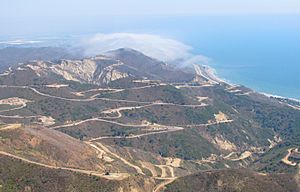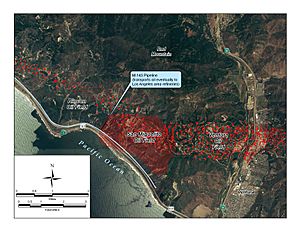San Miguelito Oil Field facts for kids
The San Miguelito Oil Field is a big area where oil is found deep underground. It's located in the hills near Ventura in southern California. This oil field is quite close to the ocean, with a major highway, U.S. Highway 101, running nearby. It's nestled between two other large oil fields: the Ventura Oil Field to the east and the Rincon Oil Field to the north.
People first discovered oil here in 1931. Since then, about 125 million barrels of oil have been taken out of the ground. That's a lot of oil! The San Miguelito Oil Field is currently managed by a company called CalNRG Operating LLC. They took over running the field in 2021.
Where in the World is San Miguelito?
This oil field is one of several that follow the direction of the Transverse Ranges mountains. To the west, you'll find the Rincon Oil Field and even an offshore field called Dos Cuadras. To the east is the much larger Ventura Oil Field. The San Miguelito field covers about 940 acres, which is roughly one and a half square miles.
The hills here rise steeply from the coast between Ventura and Carpinteria. Highway 101 takes up most of the narrow land between the beach and these hills. You might even spot one of the oil field's pumpjacks (a machine that pumps oil) right by the highway near Solimar Beach. However, most of the oil wells and other equipment are hidden from public view.
The hills are covered in tough plants like chaparral and coastal sage scrub. The land is very steep, and the dirt roads wind back and forth. Sometimes, parts of the hillsides are bare because of landslides. The weather here is like a Mediterranean climate, meaning cool, rainy winters and warm, dry summers. The ocean breezes keep things cool in the mornings. The field goes from sea level all the way up to over 1,200 feet on the highest parts of the hills.
What's Under the Ground?
The San Miguelito field holds oil in a special underground rock formation. Imagine the earth's layers folded like a wavy blanket; this is called an anticline. The oil gets trapped in these folds. There's also a big crack in the earth's crust here called the Grubb Thrust Fault. This fault has pushed different rock layers on top of each other.
The oil is found in sandy layers of rock that are very old, from the Pliocene and Miocene periods. These layers are given names like 1st Grubb, 2nd Grubb, all the way down to 5th Grubb, and even a "Grubb D" zone for the deepest parts. These layers are incredibly deep! The shallowest oil is found about 6,800 feet below the surface, and the deepest is over 14,000 feet down. That's like drilling through more than two miles of rock! The oil found here is considered medium grade.
How Oil is Found and Produced
Even though the nearby Ventura Avenue oil field was found in 1919, it took until 1931 for people to look for oil at the western end of the Ventura Anticline. They knew they would have to drill very deep to find it. The first successful well, called "Grubb No. 1," went down 7,623 feet. When they hit oil, it flowed out at over 600 barrels a day! This started the development of the entire field.
Over the years, more oil-rich layers were discovered. The 2nd Grubb Zone was found in 1944, and the 3rd Grubb in 1950. The field produced the most oil in 1951, reaching 4.5 million barrels that year. Later, the 4th Grubb was found in 1970, and the 5th Grubb in 1979. By 1983, the deepest well was already producing oil from 14,752 feet below the surface.
To help get more oil out, a process called "waterflooding" began in 1955. This involves injecting water into the ground to push the oil towards the wells, making it easier to pump out.
Over time, different companies have owned and operated the San Miguelito Oil Field. In 1993, Vintage Petroleum bought it. Then, in 2006, Occidental Petroleum bought Vintage. Later, in 2014, Occidental Petroleum created a new company called California Resources Corporation to manage its California oil fields. Finally, in 2021, CalNRG Operating LLC took over the San Miguelito oil field, along with the Rincon field. They have been working to improve and update these fields.




